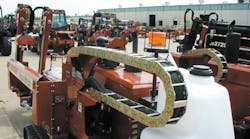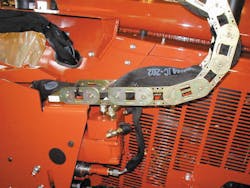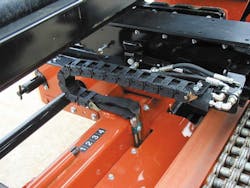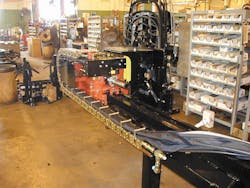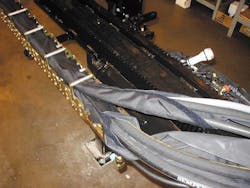Trenchless technology has become big business in the construction industry. Trenchless technology uses a horizontal directional drill (HDD) to dig a tunnel for underground pipe, cable, or other utility. This is accomplished by pushing a steerable bit into the ground and adding one section of pipe after another to advance the drill column further into the ground. The bit eventually exits the ground near its destination, usually hundreds of feet away, without disturbing the surface landscape between the entry and exit points. If a highway lies between the two points, the HDD tunnels under it, preventing any disturbance to traffic.
A leading manufacturer of HDDs is Charles Machine Works Inc., Perry, Okla., which markets the machines under its popular Ditch Witch brand. As with most HDDs, the Ditch Witch machines have a carriage that traverses forward to push the drill column into the ground, release the drill pipe, then rapidly pull back so another section of pipe can be added to the column.
The company's earliest drilling equipment simply used slack in the hoses to accommodate the carriage travel, explains Dirk Wilson, Ditch Witch product designer. He reveals, "It was the first of its kind, and the operator just walked along next to the machine as the carriage went back and forth."
Carriers extend hose life
Charles Machine Works now uses cable and hose carriers, made by A & A Mfg. Co. Inc., New Berlin, Wis., to extend cable life and eliminate the need for the operator to follow the carriage back and forth. Wilson says they allow the operator to remain in a stationary position, which reduces operator fatigue. He explains, "When we let the carriage move independently of the operator, we needed better hose management to keep them from getting tangled."
The hydraulic lines to the carriage that feed the drill pipe used in the drilling operation are the main application for the carriers. On some of the units, electrical cables also are included for controls, speed sensors, and solenoid-operated valves. "They are used on everything from our small JT520 machine up to our JT8020, which is a 265 hp machine. On the JT4020, which I worked on, the hoses are about 200-in. long, and it uses 15-ft pipe sections, so the carriage is fairly long. Some of the smaller machines use 6- or 10-ft pipe, with correspondingly shorter carriers," says Wilson.
Depending on the size of the machine, the cable and hose carriers themselves vary in length from about 6 ft to almost 15 ft. Under the constant back-and-forth motion, the cable carriers help prevent fatigue that could lead to cracking or premature failure. They also keep the hoses and electrical lines from kinking and tangling, and impart a gentle rolling motion as they follow the carriage.
Dirt, oil, and a variety of weather extremes typically are encountered operating conditions. Wilson explains, "They're exposed to the weather all the time, and users run a water and mud mixture when they are operating. When you're making and breaking pipe connections, you're splashing the mud over everything. There's also a potential exposure to hydraulic oil when servicing a machine."
A carriage typically undergoes duty cycles of between 15 and 18 sec, Wilson notes, with travel speed of about 120 ft/min on the return stroke. He explains, "When you drill the pipe into the ground, it's under control, but as soon as you need to come back up to get another pipe, you want to get drilling again as quickly as possible. To increase productivity, we run a two-speed carriage, with a button that puts it into fast speed for the return stroke."
A smaller carrier also is used on two of the company's largest drills to manage hoses to a shuttle on the pipe loader. Wilson explains, "A magazine on the side of the machine carries the drill pipe, which drops down into an arm that grabs the next length of pipe and shuttles it over to the drill frame. A small gripper on the end of the shuttle arm grips the pipe to keep it from sliding and holds it in position as it is loaded. The smaller carrier manages the hoses that route fluid to and from the gripper."
Many of the machines also use hose sleeves, which surround the hoses within the carriers to help control the hoses and to contain any oil. Wilson states, "We used to put an individual sleeve on each hose positioned where an operator could be exposed to oil. But it was difficult and time consuming to feed a long hose through a long sleeve. Now we've switched to one larger sleeve with a Velcro seam up the side to enclose all the hoses." This not only makes it easier to install during production, but also simplifies field repair or replacement. He adds, "We found that it keeps the hoses more organized. The sleeves have a strap that connects to the hose carrier's cross pieces, so things stay positioned better and don't bunch up on either end." The sleeves also are made by A & A Mfg.
Typically, a machine's main carrier includes five to seven hydraulic lines, Wilson reveals. "They vary in diameter from ½ in. on smaller machines to 1 in. on larger ones. We also run a 1¼-in.mud line through them." Pressure cycles cause the hydraulic hoses to repeatedly expand and contract in diameter and length during operation. Pressures typically run from about 3,000 psi to 4,000 and even 5,000 psi on the larger machines.
To help accommodate more lines and manage them better, the company has started using carriers with internal dividers or bars to keep the hoses separated by size. Wilson explains, "We use solid bars across the bottom part of the track for the larger hoses and extenders that give us another section on top for the smaller ones. It extends hose life by preventing smaller hoses from being abraded by the repeated expansion and contraction of the larger ones."
Wilson says the carriers have been lasting well and attributes this success to their design. "We're now using the latest models that limit the back bend. They are stiffer, yet lighter, which is a bonus because we're always looking to shave weight off the machines wherever we can."
Additional information on Gortrac cable & hose carriers is available at www.gortrac.com. Information on Ditch Witch equipment is available at www.ditchwitch.com.
